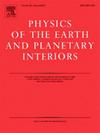Strong compositional gradient in the Earth's inner core?
IF 1.9
3区 地球科学
Q2 GEOCHEMISTRY & GEOPHYSICS
引用次数: 0
Abstract
Dynamic motions in the Earth's solid inner core driven by thermo-chemical buoyancy, such as plume convection and translation, have been proposed to explain seismic observations. The inner core should be chemically homogeneous if it is actively agitated. However, its high thermal conductivity may suppress such motions. Here we computed the equations of state for six hundred and ninety-three different Fe-Ni-Si-S-H alloys and compared their density (ρ) and bulk sound velocity (VΦ) profiles with inner core seismic reference models. While such calculations were made at static conditions, we additionally calculated the Helmholtz energy by using the quasi-harmonic approximation to obtain the ρ and VΦ of hexagonal close-packed (hcp) alloys under high temperatures relevant to the inner core. The results demonstrate that the changes in ρ of these hcp alloys along the inner core P-T profile are comparable to the radial ρ gradients shown by the PREM and AK135 models, but none of the Fe-Ni-Si-S-H alloys explain the gentle gradients in VΦ of these reference models. Given that the PREM and AK135 models provide the correct VΦ gradient, it suggests compositional stratification in the solid inner core, much stronger than can be developed upon crystallization from a homogeneous liquid outer core. The inner core might have crystallized from a chemically stratified liquid core (S-poor and H-rich toward the centre), which possibly formed as a result of liquid immiscibility between S-rich and H-rich liquids.

地球内核中强烈的成分梯度?
由热化学浮力驱动的地球固体内核的动态运动,如羽流对流和平移,已经被提出用来解释地震观测。如果内核被积极搅动,它的化学性质应该是均匀的。然而,它的高导热性可能会抑制这种运动。在这里,我们计算了693种不同的Fe-Ni-Si-S-H合金的状态方程,并将它们的密度(ρ)和体声速(VΦ)剖面与内芯地震参考模型进行了比较。虽然这些计算是在静态条件下进行的,但我们还使用准谐波近似计算了六方密堆合金在与内核相关的高温下的ρ和VΦ。结果表明,这些hcp合金的ρ沿内核P-T剖面的变化与PREM和AK135模型显示的径向ρ梯度相当,但Fe-Ni-Si-S-H合金都不能解释这些参考模型VΦ中的平缓梯度。鉴于PREM和AK135模型提供了正确的VΦ梯度,它表明固体内核中的成分分层比均匀液体外核的结晶要强烈得多。内核可能是由化学分层的液体核结晶而成(中心贫硫富氢),这可能是富硫和富氢液体不混溶的结果。
本文章由计算机程序翻译,如有差异,请以英文原文为准。
求助全文
约1分钟内获得全文
求助全文
来源期刊

Physics of the Earth and Planetary Interiors
地学天文-地球化学与地球物理
CiteScore
5.00
自引率
4.30%
发文量
78
审稿时长
18.5 weeks
期刊介绍:
Launched in 1968 to fill the need for an international journal in the field of planetary physics, geodesy and geophysics, Physics of the Earth and Planetary Interiors has now grown to become important reading matter for all geophysicists. It is the only journal to be entirely devoted to the physical and chemical processes of planetary interiors.
Original research papers, review articles, short communications and book reviews are all published on a regular basis; and from time to time special issues of the journal are devoted to the publication of the proceedings of symposia and congresses which the editors feel will be of particular interest to the reader.
 求助内容:
求助内容: 应助结果提醒方式:
应助结果提醒方式:


